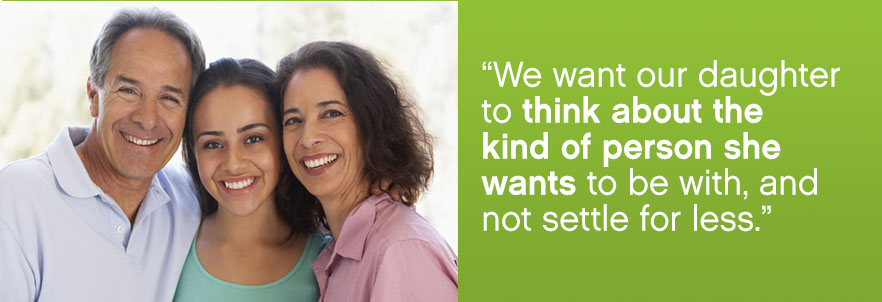What Is a Healthy Relationship?
Talking to Your Children About Relationships
Part of being a teenager is exploring new relationships. This is exciting for teens, but can be scary for parents, who don’t want to see their kids get hurt. Relationships can be supportive and help people learn more about themselves. They can also be difficult, frustrating, and even unhealthy. Your teen needs your help learning about the differences between healthy and unhealthy relationships.
Share your values.
You can help your teen understand what it means to be in a healthy relationship. By talking to your teen about respect, healthy relationships, and what your teen wants out of his/her relationships, you can help your teen stay away from or get out of an unhealthy relationship.
Talk with your teen about what you want for him or her:
- “I want you to have a boyfriend/girlfriend who respects you.”
- “I want you to have a boyfriend/girlfriend you feel really comfortable being around.”
- “I want you to enjoy your relationship with your boyfriend/girlfriend and enjoy fulfilling and healthy relationships with other people who care for you.”
Ask about what’s important to your teen.
Here are some questions you can ask your teen to get started talking about relationships:
- What would your ideal relationship be like?
- What are you looking for in a boyfriend/girlfriend?
- What comes to your mind when you think of real love?
- What do you think an abuse relationship would look and feel like?
- Do you know anyone who has a healthy relationship? What about an unhealthy relationship? Why do you think their relationship is healthy/unhealthy?
By sharing your values and listening to what’s important to your teen, you can help your teen think about what she or he really wants in a relationship.
Here are some resources to help you talk with your teen about healthy vs. unhealthy relationships:
- What Does a Healthy Relationship Look Like
- Love Is Respect: Healthy Relationships
- Am I in a Healthy Relationship?
Bullying + peer pressure
It is important for your teen to also understand what a healthy friendship looks like, especially during adolescence when peer pressure and bullying are common. In fact, almost thirty percent of U.S. students in grades 6-12 experience bullying. Here are some resources to help you talk to your teen about peer pressure and bullying:
LGBTQ youth
Lesbian, Gay, Bisexual, Transgender, and Questioning (LGBTQ) youth are twice as likely as their peers to say they have been physically assaulted and kicked or shoved at school. Twenty-six percent of LGBTQ youth say one of their biggest problems is not feeling accepted by their family. Clearly, it’s important for youth to feel supported and accepted by their families, but navigating how to support your teen - whether they are out or thinking about coming out - can be tricky.
Here are some resources to help you support your LGBTQ teen:






